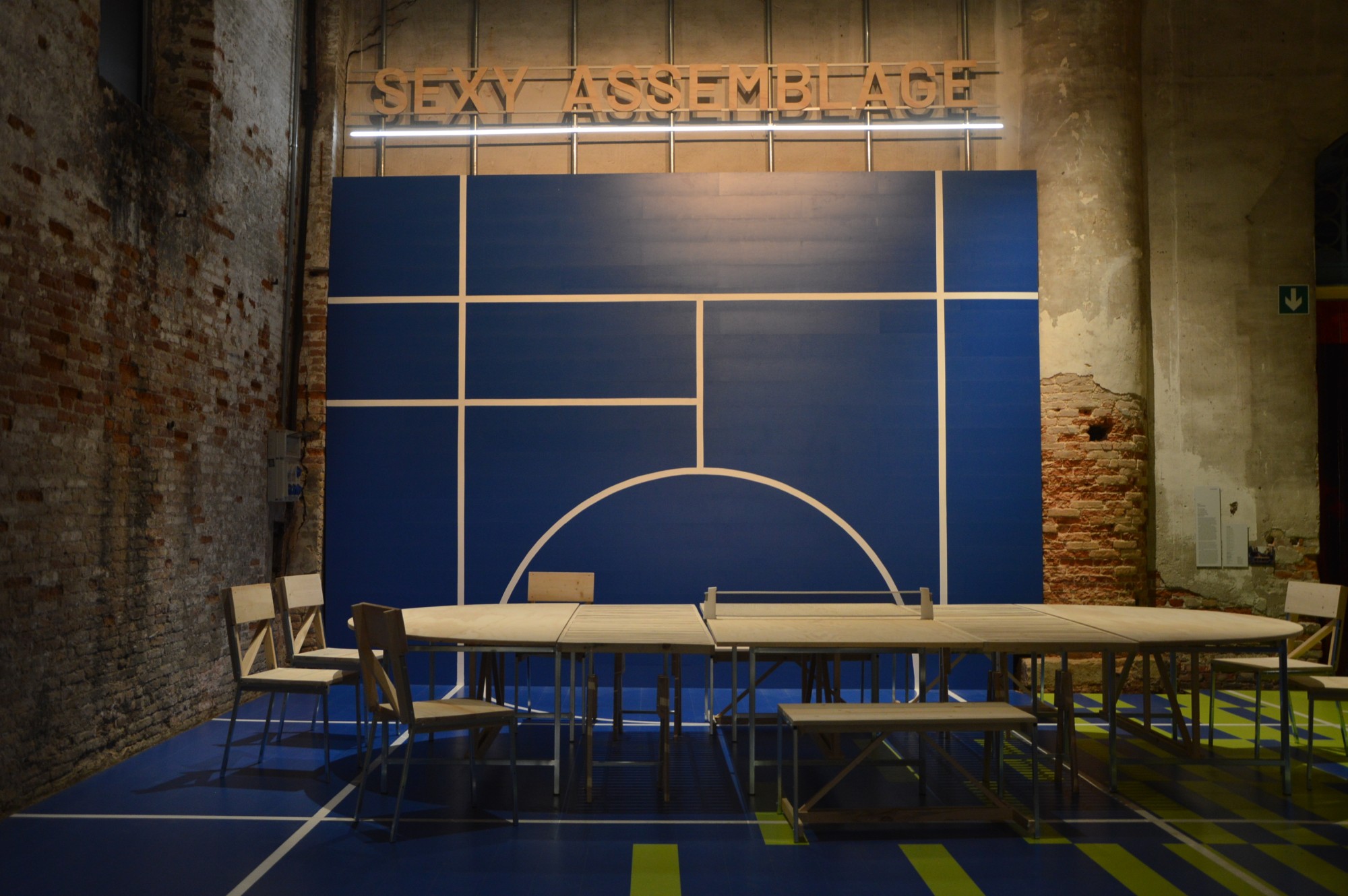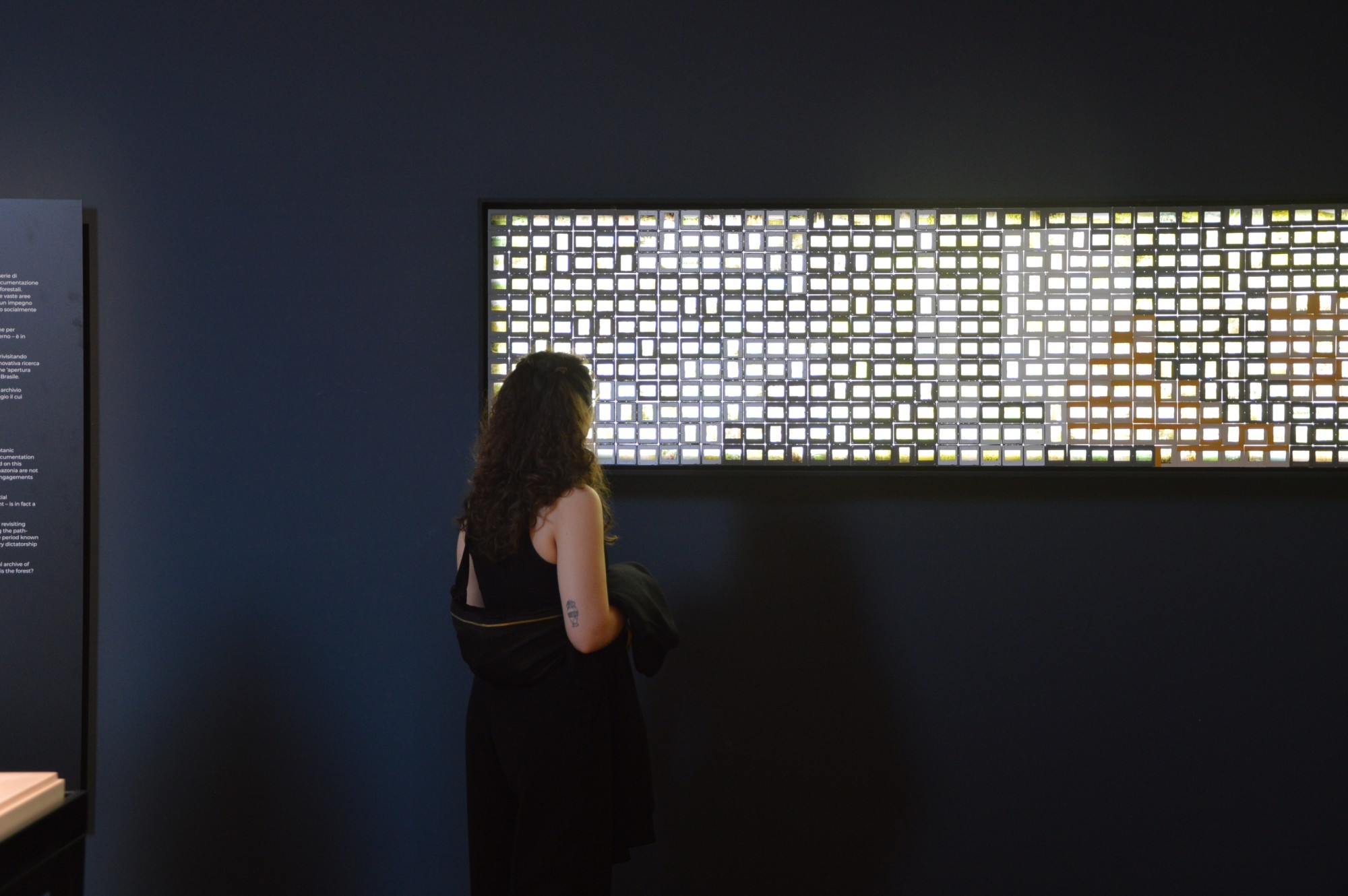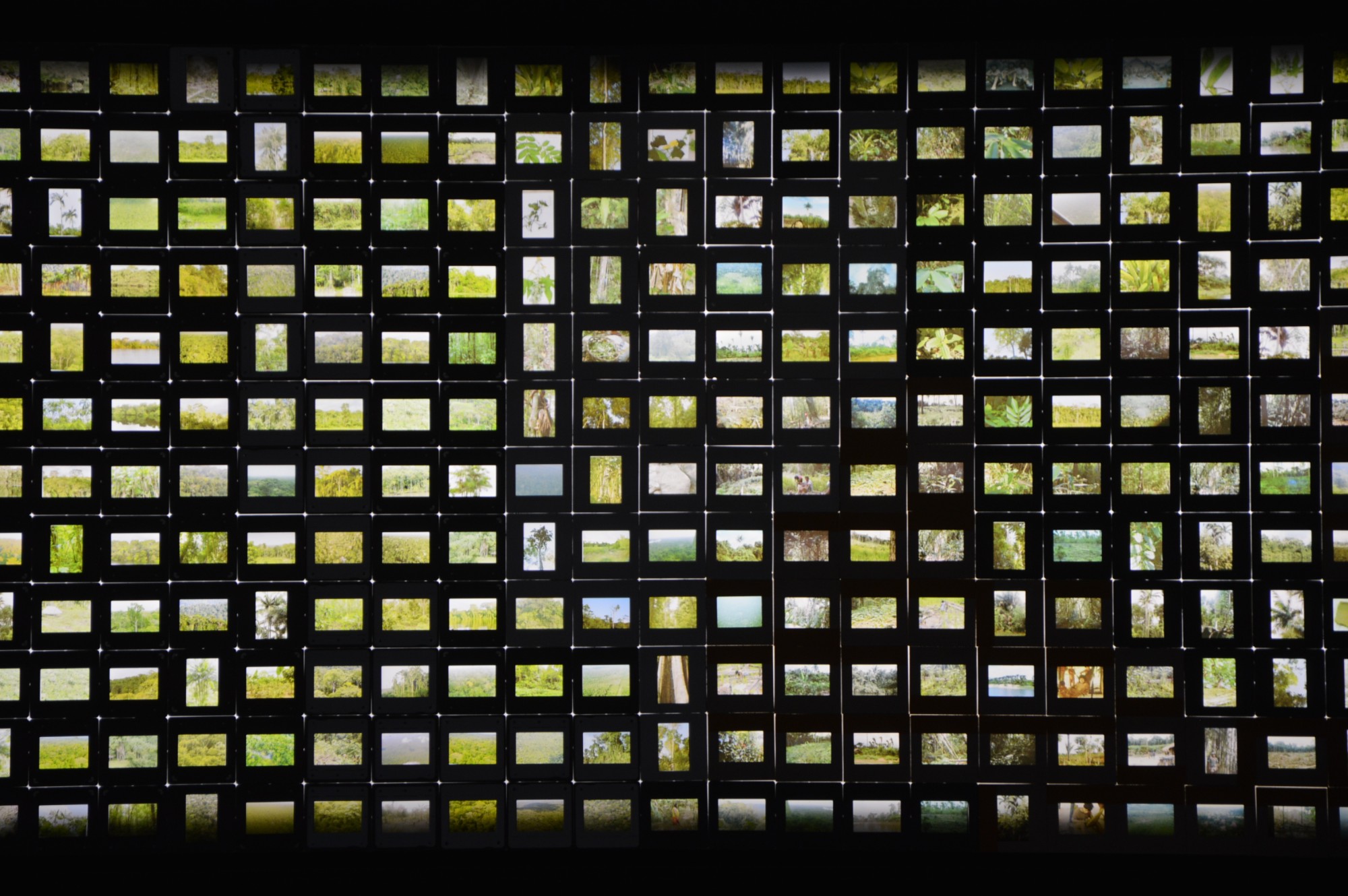Field Notes from the Pluriversity: Reflections on the 18th Venice Architecture Biennale
Nascer do chão do Pavilhão: Entrevista com Paulo Tavares
Nascer do chão do Pavilhão: Entrevista com Paulo Tavares
Pressed for time after receiving the Golden Lion for Best National Participation for his work on the Brazilian Pavilion, Paulo Tavares was hard to track down! Close to despair, Clarisse Figueiredo de Queiroz and Zachary Torres “ran into” Paulo as he was perusing the Arsenale, trying to remain anonymous. As they all sat between The Nebelivka Project and Sexy Assemblage installations, and respectful of his time, Clarisse led a quick conversation in their native Portuguese about the challenges of curating multiple exhibitions at once. Zachary struggled to follow along with their Brazilian dialect, but he did manage to get one question in!
PT: Paulo Tavares/ CFQ: Clarisse Figueiredo de Queiroz/ ZT: Zachary Torres

Acho que, para começar, estávamos curiosos para entender como é o processo de convite para ser curador da Bienal, como aconteceu essa parceria com a Gabi. Porque em alguns pavilhões é concurso, né? Se você pudesse falar um pouquinho….
I think that to start, we were curious to understand how the invitation process to be a curator of the Biennial works, and how did this partnership with Gabi happen? Because in some pavilions, it's a contest, right? If you could speak a little on this….
Fomos convidados pelo presidente da Fundação Bienal através de uma carta para desenvolver um projeto em conjunto em uma competição interna. Havia outros participantes na competição, e nós fomos selecionados.
We were invited by the president of the Bienal Foundation through a letter to develop a joint project for an internal competition. There were other participants in the competition, and we were selected.
E quando isso aconteceu e por quanto tempo?
And when did that happen and for how long?

Olha, quando isso aconteceu... Minha memória não vai ser muito boa para falar sobre isso. Mas tivemos cerca de um mês para fazer o projeto, mais ou menos. Um pouco mais…. A Gabriela e eu nunca tínhamos trabalhado juntos. Na verdade, nem nos conhecíamos. E, por alguma razão, eles nos enviaram uma carta pedindo que submetêssemos um projeto juntos. E o processo foi super fluido, super interessante, porque nossas práticas de alguma forma estão conectadas. Apesar de serem muito diferentes, há vários pontos de intersecção. Então, o processo foi muito orgânico, muito prazeroso, muito natural.
Look, when that happened…. My memory isn't going to be very good to talk about this. But we had about a month to do the project, more or less. A little more….Gabriela and I had never worked together. In fact, we didn't even know each other. And, for some reason, they sent us a letter asking us to submit a project together. And the process was super smooth, super interesting because our practices are somehow connected. Despite being very different, there are several points of intersection. So, the process was very organic, very enjoyable, very natural.
Dos pavilhões e dos projetos especiais que você teve a oportunidade de ver desde que chegou, há algum que você considere que está mais em diálogo com o Pavilhão do Brasil? Eu vi alguns que achei interessantes, mas gostaria de ouvir também a sua opinião. Algum que você consiga traçar conexões, digamos.
Of the pavilions and special projects that you've had the opportunity to see since you arrived, is there any that you consider to be more in dialogue with the Brazil Pavilion? I've seen some that I found interesting, but I'd also like to hear your opinion. Any that you can draw connections to, let's say.
Eu acho que existem vários pavilhões que estão, vários trabalhos que estão conectados com o Pavilhão do Brasil na medida em que muitos dos projetos falam de questões decoloniais, né? Muitos dos projetos também falam, de alguma maneira, da terra, de aspectos arqueológicos da terra, de aspectos simbólicos da terra, de aspectos que estão relacionados com um certo olhar tanto para a terra como espaço de memória, mas também como espaço de habitação da espécie humana e de outras espécies. E eu acho que esse é um tema que reverbera durante toda a exposição. Então, haveria inúmeros trabalhos que eu poderia citar, mas eu não vou citar nenhum, já que você mencionou que já fez essa relação. Mas existem vários trabalhos que estão tratando do tópico da decolonização. E eu acho que, por exemplo, um trabalho que eu poderia citar é o projeto que ganhou o Leão de Ouro, que é o Decolonize Architecture, e eles estão falando do estado de decolonização de movimentos de arquiteturas modernas fascistas, né? Que estão relacionadas com processos de colonização, por exemplo, e a gente fala sobre isso em relação a Brasília. Esse processo de decolonização desse paradigma moderno-colonial na arquitetura, e esse poderia ser um exemplo. Deixa eu pensar….Vários outros projetos que estão tratando de extração de recursos naturais. O projeto do Sammy Baloji. O projeto da Thandi Loewenson também está falando muito sobre isso, o que eu acho que de alguma maneira se interconecta com o que a gente está fazendo. Acho que é isso.
I think there are several pavilions, several works that are connected with the Brazil Pavilion in the sense that many of the projects address decolonial issues, right? Many of the projects also discuss, in some way, the land, archaeological aspects of the land, symbolic aspects of the land, aspects related to looking at the land as a space of memory, but also as a space of human and other species’ habitation. And I think this is a theme that resonates throughout the entire exhibition. So, there are numerous works that I could mention, but I won't mention any, since you mentioned that you've already made that connection. But there are several works addressing the topic of decolonization. And I think, for example, a work I could mention is the project that won the Golden Lion, which is Decolonize Architecture, and they are discussing the state of decolonization of fascist modern architectural movements, right? Which are related to colonization processes, for example, and we talk about this in relation to Brasília. This process of decolonizing this modern-colonial paradigm in architecture, and that could be an example. Let me think.... Several other projects dealing with the extraction of natural resources. Sammy Baloji's project. Thandi Loewenson's project is also discussing this a lot, which I think somehow interconnects with what we're doing. I think that's it.
Você chegou a ver um, que eu acho que está há duas salas para cá [aponta para a direita], que é um vídeo com a população Inga na Colômbia. É do lado…
Did you happen to see one, which I think is about two rooms down [points to the right], that's a video with the Inga population in Colombia. It's right over there….
População Inga?
Inga population?
Inga. Você anda para cá e dobra à direita. Não sei se você viu.
Inga. You walk here and turn right. I don't know if you saw it.
Não, não vi. Por conta do tempo, não consegui ver muita coisa. Mas acredito que outro aspecto pelo qual nosso pavilhão se destaca na exposição é a inclusão dos conhecimentos indígenas dos povos originários no cerne da temática e da discussão sobre arquitetura. Além disso, há a questão do espaço negro, do “Black space.” Nosso pavilhão está intimamente relacionado com a questão afro-brasileira, que é um tema que permeia toda a Bienal. Esta Bienal aborda amplamente as arquiteturas diaspóricas, como podemos chamar. E isso é algo que também está central em nosso pavilhão.
No, I didn't see. Due to lack of time, I couldn't see much. But I believe that another aspect by which our pavilion stands out in the exhibition is the inclusion of indigenous knowledge from native peoples at the core of the theme and the discussion about architecture. Additionally, there's the issue of Black space. Our pavilion is closely related to the Afro-Brazilian issue, which is a theme that permeates the entire Biennale. This Biennale extensively addresses diasporic architectures, as we can call them. And this is also something that is central in our pavilion.
Essa é a minha primeira bienal, e é a bienal que todo mundo está falando que é a mais diferente, que tem uma sensação diferente em relação às outras bienais…. Então é muito simbólico também o Brasil estar ganhando neste momento.
This is my first Biennale, and it's the Biennial that everyone is talking about as being the most different, with a different feeling compared to others…. So it's also very symbolic for Brazil to be winning at this moment.
Com certeza. O prêmio não teria o mesmo significado se tivesse sido em outra Bienal, e provavelmente não teria acontecido se fosse em outra Bienal, talvez. Esta é uma Bienal muito especial, paradigmática, por diversas camadas, por diversas razões. E acho que, nesse sentido, é uma honra ter sido laureado com o Leão de Ouro justamente nesta bienal.
Certainly. The award wouldn't have the same meaning if it had been in another Biennale, and probably wouldn't have happened if it were in another Biennale. This is a very special, paradigmatic Biennale on several layers and for various reasons. And I think, in that sense, it's an honor to have been awarded the Golden Lion precisely at this biennial.

Organizationally, how was it to have your own project here in the Arsenale and organize the Brazilian Pavilion at the same time?
Organizacionalmente, como foi ter seu próprio projeto aqui no Arsenale e organizar o Pavilhão Brasileiro ao mesmo tempo?
It was a nightmare. Yeah, it's somehow a bit unusual, I believe, you know, the fact that I have a large installation at the Arsenale and, at the same time, being the curator of the Pavilion. So, of course, it has been—both works—both projects demanded a lot of labor. But what is interesting, is that the scale of production of those projects is completely different, right? One is a kind of very long-term project, which I have been doing for many, many years. And a project that I will continue doing because it's part of my practice. It's a project very much related to activism, to architectural advocacy, as I like to say. You know, if the city is territory, if space, if the environment is alive, architecture is a mode of advocacy. The pavilion is a short-term project, one month to elaborate, five months to complete the project. So it's a completely different sort of modality of work. But they are related on many different levels, right? On many different layers, they are related. Not only because both of them are speaking of the Earth, right? But also of heritage, which is also a central theme in the pavilion. So it's very natural because, you know, the Brazilian Pavilion….me and Gabi de Matos brought our practice and our interests in combination together in dialogue. So it feels very natural that this happened.
Foi um pesadelo. Sim, é de alguma forma um pouco incomum, eu acredito, sabe, o fato de eu ter uma grande instalação no Arsenale e, ao mesmo tempo, ser o curador do pavilhão. Então, é claro, foi—ambos os trabalhos—ambos os projetos exigiram muito trabalho. Mas o que é interessante, talvez, dizer, é que a escala de produção desses projetos é completamente diferente, certo? Um é um tipo de projeto de longo prazo, que é o que venho fazendo há muitos, muitos anos. É um projeto que continuarei fazendo porque faz parte da minha prática. É um projeto muito relacionado ao ativismo, à advocacia na arquitetura, como costumo dizer. Se a cidade é território, se o espaço, se o ambiente está vivo, a arquitetura é um modo de advocacia. O Pavilhão é um projeto de curto prazo, sabe, um mês para elaborar, cinco meses para concluir o projeto. Então é um tipo de modalidade de trabalho completamente diferente. Mas eles estão relacionados em muitos níveis diferentes, certo? Em muitas camadas diferentes, eles estão relacionados. Não apenas porque todos eles estão falando muito sobre a Terra, certo? Mas também sobre patrimônio, que também é um tema central do Pavilhão. Então é muito natural porque o Pavilhão Brasileiro.. eu e Gabi de Matos que trouxemos nossa prática e nossos interesses em combinação juntos em diálogo. Então parece muito natural que isso tenha acontecido.

How do you think the media that you chose for the pavilion translates its message?
Como é que o media que você escolheu para o pavilhão traduzem o seu messagem?
I think that one thing that is important and that was also pointed out by the jury was that the pavilion is a research-based pavilion. So the pavilion is kind of an intervention in architecture. You know, we designed a huge site specific installation that we called ATERRAMENTO—that means landing—where we ground the entire pavilion. And so there is a labor of architecture there, which understands that the pavilion’s architecture itself is a media and that you cannot shift the medium of the message. So, the pavilion…. Yes, there's different media, but I think something to highlight is how we understand the very construction of the pavilion, the very history of the pavilion, and its symbolic character, its political character, its ideological character as a medium of intervention. Therefore we designed it not only as a display to show the projects but as an architectural intervention in the building.
Eu acredito que uma coisa importante, e que também foi apontada pelo júri, é que o pavilhão é um pavilhão baseado em pesquisa. Então, o pavilhão é meio que uma intervenção na arquitetura. Você sabe, nós projetamos uma instalação específica para o local que chamamos de ATERRAMENTO—que significa aterrissagem—onde nós aterramos todo o pavilhão. E assim, há um trabalho de arquitetura ali, que entende que a própria arquitetura do pavilhão é um meio e que você não pode dissociar o meio da mensagem. Então, o pavilhão... Sim, existem diferentes meios, mas eu acho que algo a destacar é como entendemos a própria construção do pavilhão, a história do pavilhão e seu caráter simbólico, seu caráter político, seu caráter ideológico como um meio de intervenção. Portanto, nós o projetamos não apenas como uma exibição para mostrar os projetos, mas como uma intervenção arquitetônica no prédio.
That even comes and is born from the pavilion’s floor.
Que até mesmo vem e nasce do chão do Pavilhão.
Yes, yes.
Sim, sim.